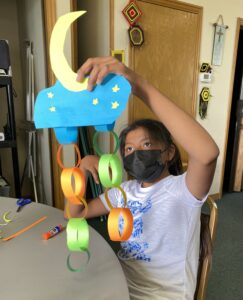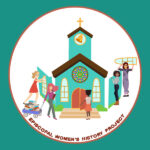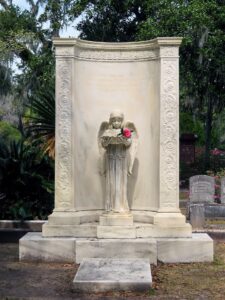Do We Need the Episcopal Church Women Anymore?
Hi, my name is Heather Sessing, and I am president of the Diocesan ECW for the Diocese of Oklahoma.
I am occasionally asked if there is a need for ECW anymore. I believe that yes there is a need for the ECW because women will always need other women. Part of the original mission for the ECW was to raise up women in the church to one day serve as clergy and other leadership roles, and praise be to God we have had women at many levels of church leadership, including Presiding Bishop. Alongside all of the progress women have seen in the church, I will always need the love and guidance of the women around me, both lay and clergy, to help me grow into a better person and follower of Christ.
Studies have shown that even with increased digital connectivity, our world is an increasingly lonely place. I know that as long as I’m part of the ECW, I will be connected to a group of people who want to make this world a better place through loving and serving Christ. To quote Together: The Healing Power of Human Connection in a Sometimes Lonely World by Dr. Vivek H. Murthy, MD, “Giving and serving others doesn’t just strengthen our own communities; it enriches our lives and strengthens our own bonds to the community and our sense of value and purpose.”
We know what a wonderful organization the ECW is because we have seen the benefits of it in our own lives. I am part of this organization because someone reached out and included me. As a working mother of two young kids, I understand the challenge of busy schedules. My hope for this group is that we find ways to meet the women in our churches and communities where they are and show them the love and connection that we have. We may be over-connected electronically, but the message of love and true connection will always be needed.

 Tu nunca deberías preguntarse si las mujeres episcopales pueden cambiar el mundo. Lo ves todos los días. Pat Sanger de Park City, Utah, fue una de ellas ya que vio una necesidad en la Reserva Ute en la pequeña ciudad de Whiterocks, Utah, y actuó de manera consecuente sobre ella.
Tu nunca deberías preguntarse si las mujeres episcopales pueden cambiar el mundo. Lo ves todos los días. Pat Sanger de Park City, Utah, fue una de ellas ya que vio una necesidad en la Reserva Ute en la pequeña ciudad de Whiterocks, Utah, y actuó de manera consecuente sobre ella. El Proyecto de Historia de las Mujeres Episcopales (EWHP) se fundó en 1980 para preservar las historias de las mujeres de la Iglesia Episcopal. Sus fundadoras, Mary Donovan y la fallecida Joanna Gillespie, colaboraron con mujeres líderes de la iglesia para comenzar esta organización, y hasta el sol de hoy todavía cuenta historias de mujeres. La declaración de nuestra misión es: El Proyecto de Historia de las Mujeres Episcopales honra los ministerios de las mujeres en la Iglesia Episcopal escuchando, grabando y contando sus historias continuamente.
El Proyecto de Historia de las Mujeres Episcopales (EWHP) se fundó en 1980 para preservar las historias de las mujeres de la Iglesia Episcopal. Sus fundadoras, Mary Donovan y la fallecida Joanna Gillespie, colaboraron con mujeres líderes de la iglesia para comenzar esta organización, y hasta el sol de hoy todavía cuenta historias de mujeres. La declaración de nuestra misión es: El Proyecto de Historia de las Mujeres Episcopales honra los ministerios de las mujeres en la Iglesia Episcopal escuchando, grabando y contando sus historias continuamente. Episcopal Women’s History Project (EWHP)
Episcopal Women’s History Project (EWHP) En nuestro sitio web, Chapelofthecrossms.org, uno puede notar algo un poco diferente a la página web habitual de la iglesia. En la pestaña “Participar” hay una sección que se exhibe como Gremio de sepultureros. Así mismo, esto es lo que a continuación aparece: nosotros, como grupo, cavamos las tumbas de nuestros miembros. Si hace clic en la pestaña indicada, dice: “Aquí en la Capilla cavamos nuestras tumbas a mano. Todos y cada uno de nosotros están invitados a unirse a esta experiencia verdaderamente espiritual. Hay algo en ser parte de la excavación que te hará meditar sobre tu propia vida. Usando picos y palas, amorosamente brindamos un lugar de descanso eterno para aquellos de nosotros que hemos ido a estar con Él. Ya sea que quieran excavar u observar, todos son bienvenidos. Algunos traen una espalda fuerte para laborar, otros traen comida y bebida (esto es el sur), algunos traen oraciones y otros traen un corazón agrietado. Hay algo muy especial en el compañerismo que proporciona y rodea ser parte del Gremio de Sepultureros. Únete a nosotros.”
En nuestro sitio web, Chapelofthecrossms.org, uno puede notar algo un poco diferente a la página web habitual de la iglesia. En la pestaña “Participar” hay una sección que se exhibe como Gremio de sepultureros. Así mismo, esto es lo que a continuación aparece: nosotros, como grupo, cavamos las tumbas de nuestros miembros. Si hace clic en la pestaña indicada, dice: “Aquí en la Capilla cavamos nuestras tumbas a mano. Todos y cada uno de nosotros están invitados a unirse a esta experiencia verdaderamente espiritual. Hay algo en ser parte de la excavación que te hará meditar sobre tu propia vida. Usando picos y palas, amorosamente brindamos un lugar de descanso eterno para aquellos de nosotros que hemos ido a estar con Él. Ya sea que quieran excavar u observar, todos son bienvenidos. Algunos traen una espalda fuerte para laborar, otros traen comida y bebida (esto es el sur), algunos traen oraciones y otros traen un corazón agrietado. Hay algo muy especial en el compañerismo que proporciona y rodea ser parte del Gremio de Sepultureros. Únete a nosotros.”